Click on the picture for a larger version. To return, use the back button.
.
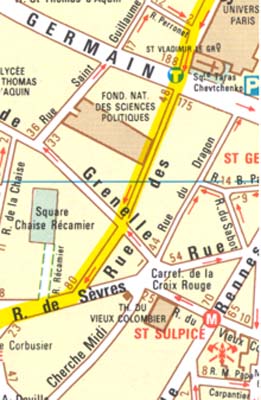
Map of the main area of route stop 9, rue du Sabot
.
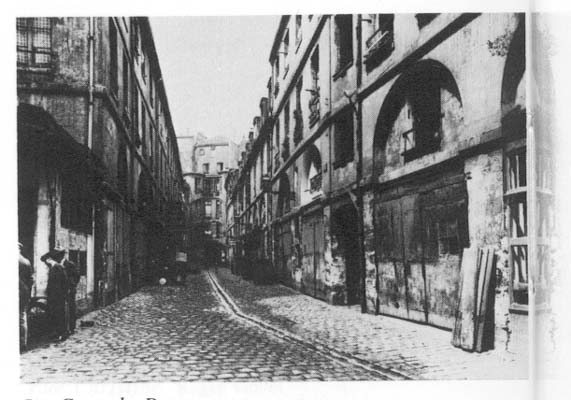
The rue Dragon in 1950 [Vian p264 credit Roger Viollet]
.
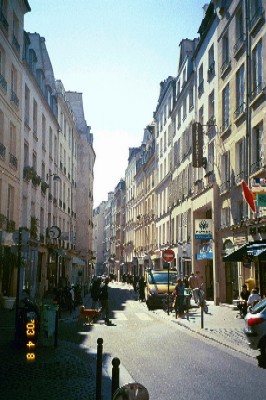
The rue Dragon now
.
About the rue Dragon: A short, narrow street formerly known as the rue du Sépulcre because it was the residence of the Canons of Saint-Sépulcre. The northern end is marked by a doorway over which there is a sculpted dragon bearing up a balcony. Traditionally a street of shops and restaurants, now also fashionable boutiques.
.
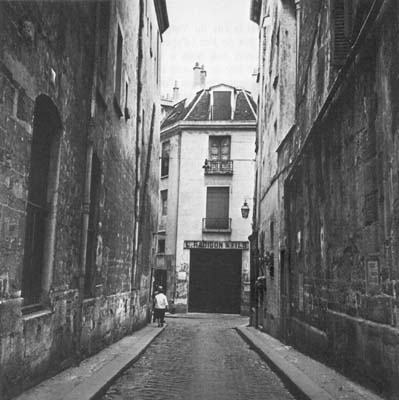
The rue Bernard-Palissy in 1950 [Vian p259 credit Roger Viollet]
.
About the rue Bernard-Palissy: This was once called the rue Taranne after a family which lived there in the 15th century; since 1864 it has been named after Bernard Palissy (1510-1589), whose house stands at the head.
.
About the rue du Sabot: A name originating in the 15th century. Sabots, or wooden shoes, were much worn during the Occupation when leather was unavailable and the knocking of sabots on cobblestones was a characteristic sound of the time, reminiscent of deprivation.
.
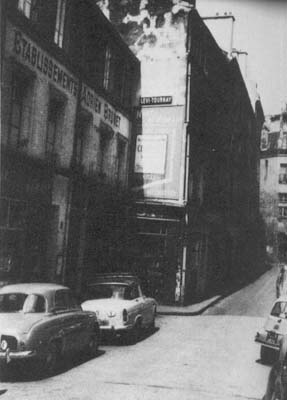
The rue du Sabot in 1950 [Vian p272 credit Roger Viollet] Seaver's warehouse is the building on the left, where the two cars are parked.
.
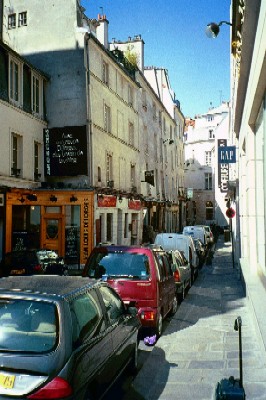
The rue du Sabot now, corresponding to the viewpoint of the 1950 picture.
.
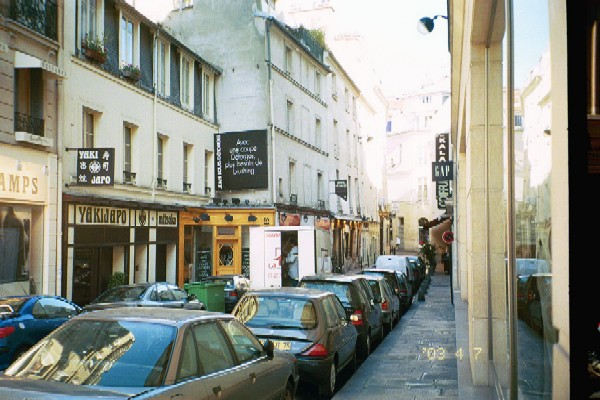
The rue du Sabot in 2003, with a better view of n8, the Merlin warehouse as it is now.
.
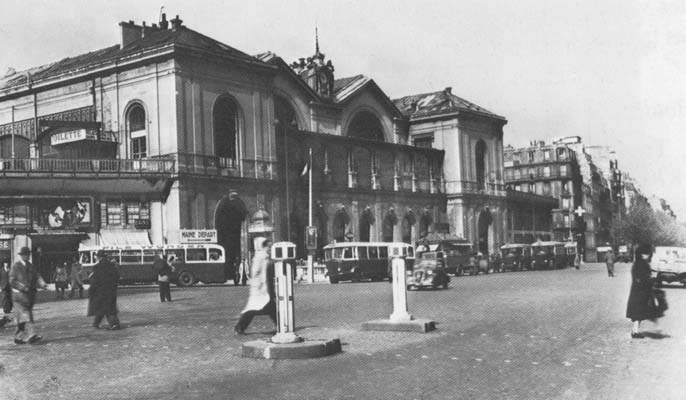
The rue de Rennes in 1950 [Vian p271]
.
About the rue de Rennes: The rue de Rennes runs 1195 meters from the Place du Québec at the north end, where it meets the Boulevard Saint-Germain, to the Place du Dix-Huit Juin 1940 (formerly known as the Place de Rennes) at the head of the Gare de Montparnasse complex, where the trains for Rennes and Brittany once departed. Laid out in 1855, it is a major street 22 meters wide. In 1977 the section beyond the Boulevard Saint-Germain was assigned to a different street.
.
On associations with the rue de Rennes: The only person I have so far found associated with the rue de Rennes was Paul Boubal, patron of the Café Flore from 1939, who owned an apartment on the corner with the rue Gozlin.
.
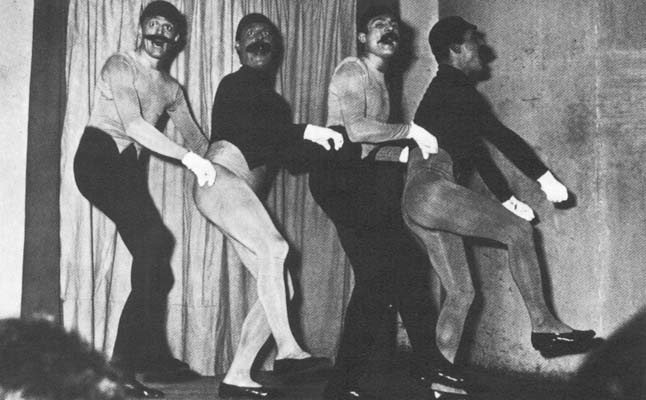
Les Frères Jacques, performing at the Rose Rouge [Vian p213 credit Georges Dudognon]
.
Associations with the Rose Rouge: Although the address of the Club Saint-Germain in 1948 was 44 rue de Rennes, this is now the rue Bonaparte north of the Boulevard. The original Rose Rouge was a partnership between Feral Benga and Nico, which lasted a year. Benga continued on at the rue de la Harpe site, while Nico (the husband of Anouk Aimée) established, in 1948, a new club, also named the Rose Rouge, in the rue de Rennes. The club's fame was built on shows by the team of Jean-Pierre Grenier and Olivier Hussenot and by the satirical review Les Frères Jacques, mentioned by Janet Flanner (11 May 1949) as performing Queneau's Exercises du Style. The mania for jazz aux caves had collapsed after the spring of 1949 when the police cracked down (why?) and by 1951 the jazz scene had moved on to the kind of sit-down clubs and bars by that time familiar to any New Yorker. In 1950 the Rose Rouge was said to be keeping its head down, and scored a coup rather with a spectacle based on Fantômas, a series of thrillers popular before World War I.
.
An intractable problem. On Les Frères Jacques and Le Compagne Grenier-Hussenot: are there eye-witness accounts of these shows? On satirical reviews, music halls, and "shows." On the tourist consumption of shows. This kind of entertainment was seemingly not something the Merlin people did: was it tourist fare only? Was it too expensive? Merlin people seem not to have gone to the clubs, either.
.
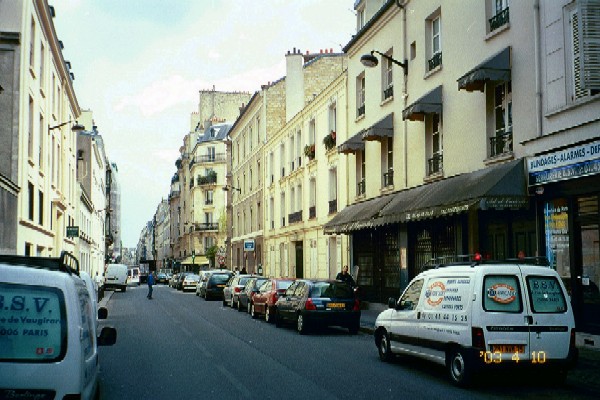
Rue Vaugirard now; n89, once inhabited by Lawrence Ferlingetti, is halfway along on the right side.
.
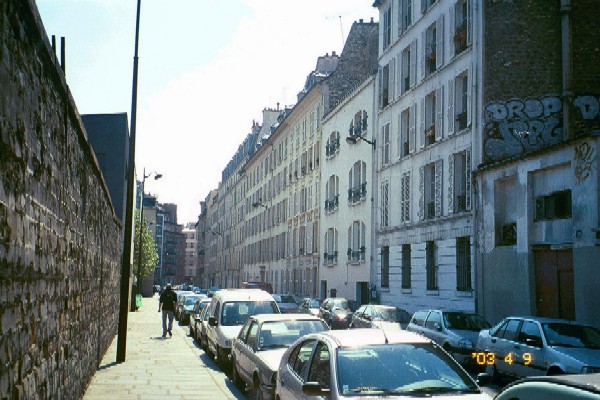
Rue Henri Barbusse now. Mason Hoffenberg lived in this neighborhood.
.
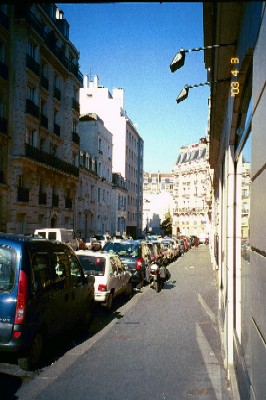
Rue Leconte de Lisle now. Jane Lougee lived in this neighborhood when she first came to Paris.
.
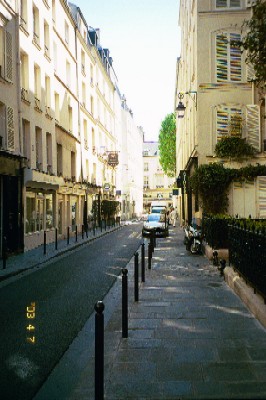
Rue de Verneuil now, with the Hôtel Verneuil at the sign.
.
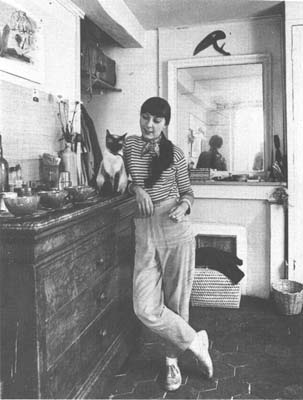
Jane Lougee and Fuki in her room at the Hôtel Verneuil in 1954 [Scott credit Lennary Olson]
.

Juliette Gréco in bed in the Hôtel Louisiane about 1950. [Vian p204 credit Georges Dudognon]
.
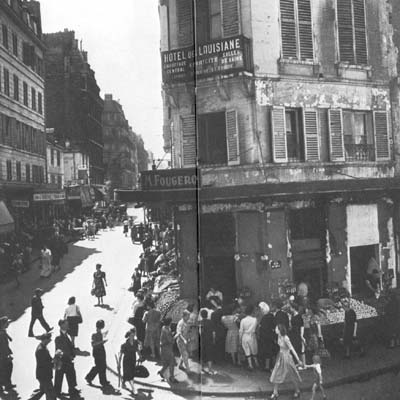
The façade of the Hôtel Louisiane in 1950 [Vian p34 credit Doisneau-Rapho]
.
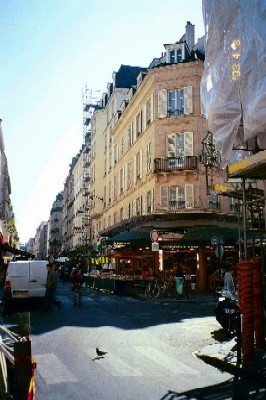
The façade of the Hôtel Louisiane now
.
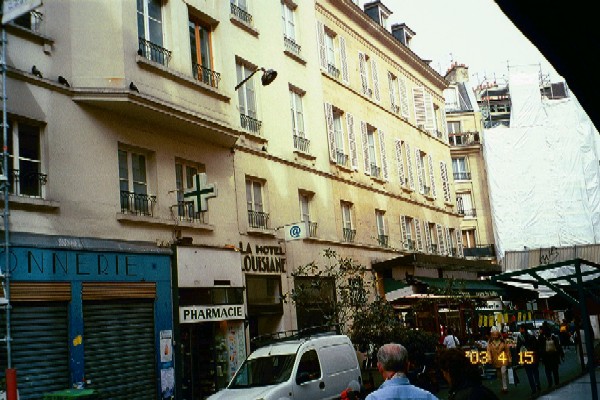
The entrance of the Hôtel Louisiane now, on the rue de l'Ancienne Comédie
.

Merlin people and others at a reception, December 1953 [Scott credit H Riemens] Back row left to right: George Plimpton, Corneille, Richard Seaver, Mary Smith (Gaïte Frogé's assistant in the English Bookshop), Patrick Bowles, Gaïte Frogé, Jane Lougee. Front row left to right: Christopher Logue, Austryn Wainhouse, Christopher Middleton.
.
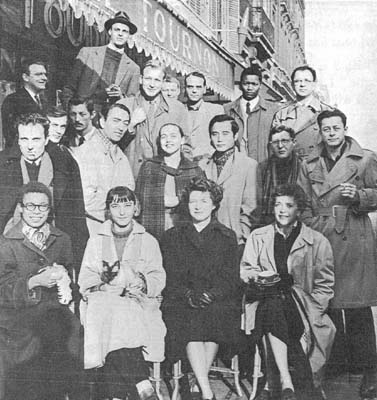
Merlin and Paris Review people outside the Café Tournon, 1954. Front row left to right: Wilma Howard, Jane Lougee and Fuki, Muffy Wainhouse, Jean Garrigue. Seond rom: Christopher Logue, Richard Seaver (looking over Logue's shoulder), Evan S Connell (with the moustache), Niccolo Tucci, unidentified woman, Peter Huyn, Alftred Chester, Austryn Wainhouse. Third row: Eugene Walter, George Plimpton, William P=ne du Bois, James Broughton, William Gardner Smith, Harold Witt.
.
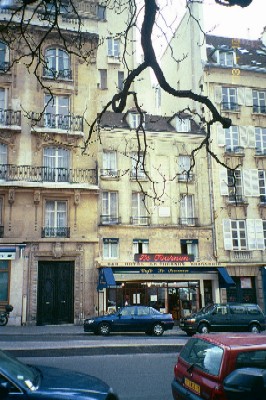
The Café Tournon now
.
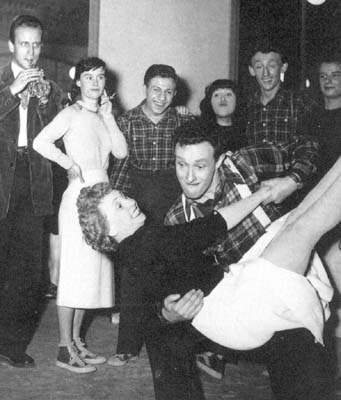
Jean-Louis Barrault, the manager of the Odéon theatre, and his wife, the actress Madeleine Renaud, dancing to le jazz hot in 1950 [Beevor]
.
Details of Merlin: The first issue of Merlin contained, in addition to work by Trocchi and Chistopher Logue, the editor/publishers, and Alfred Chester (then living in a Paris suburb), material from a Dallas poet in Paris on a Fullbright (William Burford), an English little magazine editor (Patrick Brangwyn), another Englishman (James Fidler), a Canadian living in London (H Charles Hatcher), and A.J. Ayer on existentialism. It was, as we see, not yet French.
The second issue (Autumn 1952, 115 pages) contained the article by Seaver on Beckett, and the third (Winter 1952, 68 pages) material from Watt. The connection with Les Temps Modernes had been made by the fourth issue (Spring/Summer 1953, 71 pages), which contained writing by Paul Eluard and by Sartre on Jean Genet as well as a fragment of Henry Miller's Plexus. After this things started to go downhill. The fifth issue (Autumn 1953, 60 pages) contained some of Beckett's Molloy, but it had a business manager now, and was printed in Spain. Trocchi had begun to withdraw, leaving the editorial work to Seaver and others. The next (sixth) issue (Summer/Autumn 1954, 87 pages) did not appear for almost a year, and with a new business manager and new volume numbering (v2n3). This was the end of Lougee's association.
.
Workpoints:
On the relations between the French scenes and the foreigners: Vian's jazz youth scene and the radical/hip Trocchi for example. Appear to be none. Why? Timing? Money?
On the fading of scenes.
On Richard Seaver's subsequent career as a Grove Press editor (the influential Evergreen Review) and translator.
On subsequent careers generally.
On the Old Navy bar.
On the mysterious Grap d'Or and "pinball."
Sources:
Beevor, Anthony and Artemis Cooper. Paris After the Liberation 1944-1949. London: Hamish Hamilton, 1994.
Scott, Andrew Murray. Alexander Trocchi: The Making Of the Monster. Edinburgh: Polygon, 1991.
Vian, Boris. Manuel de Saint-Germain-des-Prés. Paris: Chêne, 1974.






















